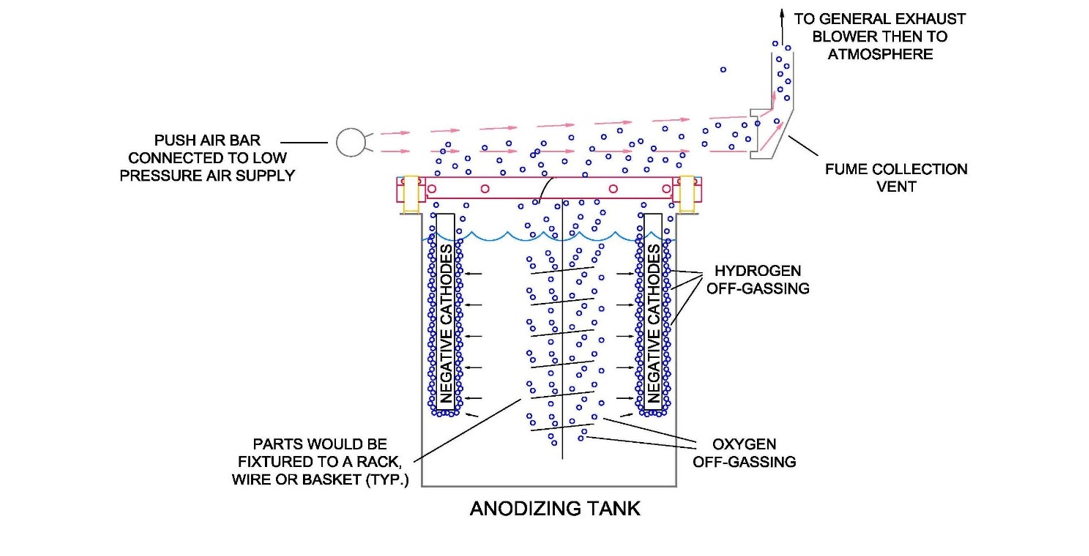Regulatory Agencies and Permits
There are two big questions that potential customers are usually very leery of when considering purchasing and installing a titanium anodizing line- The first is whether the learning curve is such that they can really learn to do it, quickly, reliably and repeatably. We have several articles on this subject and we have yet to find a customer who was not able to learn the process within a matter of weeks. The second question and perhaps the biggest in some people’s minds is regarding regulatory agencies and permits.
We have seen so many differences in permit requirements throughout different states, municipalities, cities, counties and townships throughout the United States (and even in Europe and Asia) that I’ve always been reluctant to try to generalize about permit requirements and the regulatory agencies involved. Still, we get so many phone calls and emails about this aspect of installing a titanium anodizing line that I would like to give some insight beyond what we provide in our free email classes. Note that most of our customers have found no need for permits to install an IPEC titanium anodizing line in their facility, but that is no guarantee that you won’t, so the following are some generalities based upon our experiences with different customers in different regions around the country…
Some Questions and Answers Regarding Permits and Regulatory Agencies
The following are some of the questions that we have been asked from past and current customers, along with our answers to the questions.
- Are there any combustible metals / shavings / dust produced in the process?
- No.
- Are there any VOCs (volatile organic compounds) used in this process?
- We are not aware of any VOC-bearing chemistries used for this type of process
- Will fire sprinklers be needed in the exhaust vent pipe?
- Most agencies we have dealt with, plus Factory Mutual (FMC), have a requirement for fire sprinklers in PVC and some fiberglass vent ducts larger than 10” in diameter. The vent ducts for this type of system are usually 6” to 8” in diameter, so fire sprinklers would not be needed, and “standard” schedule 80 PVC pipe can be used.
- Will the equipment include information such as chemical concentrations, temperatures, ventilation, etc. so the fire department will know what chemicals are involved and at what concentrations?
- Yes. That will be provided along with the engineering package when a system is purchased from IPEC. We provide an equipment matrix with pumps, filters, DC electrical specs, exhaust ventilation flow, push air and air agitation specfications, chemical make-up, operating temperatures, tank volumes, tank or liner materials of construction, water inlets, overflows, etc. on a tank-by-tank basis for the entire line. We also provide layout drawings of the process line and a utility point-of-connection drawing both for permits and for bringing electrical to the line and any ancillary equipment needed for the line.
- Do we need to set up the exhaust system or can we operate the system without it?
- If your expected production numbers are low enough, you may not need to exhaust (but if not, you should use a face respirator). If you are producing consistently, the off-gassing from the etch and the anodizing tanks will probably be too strong for your operators without ventilating.

A diagram showing why to exhaust an anodizing tank
- Will we need a scrubber or a HEPA filter for our exhaust ventilation?
- We have not had any customers who have been asked to install scrubber or a HEPA filter on the exhaust air. The metals in this system are not regulated (titanium plus some various alloyed metals in very small quantities), plus the chemistries involved are usually pretty dilute and do not require scrubbing.
- What personal protective equipment (PPE) would be required to operate a titanium anodizing line?
- The following are what we would expect a customer to have and to use when operating a titanium anodizing line-
- Chemically resistant (rubber or neoprene) gloves
- Chemical goggles
- Long-sleeve shirt, rubber apron
- An installed eyewash or eyewash / shower, usually within 10 seconds from the line with clear, unobstructed access (there are certain requirements for the installation of this that may necessitate a professional plumbing contractor and permits)
- A face respirator (only if an exhaust system is not installed)
- What agencies would need to be involved in permitting this type of equipment? The agencies involved in permitting are different from place to place, but on a “worst case” scenario, which is usually large municipalities (especially here in California), here are the agencies we have dealt with and their jurisdictions:
- City Planning or Building Department-
- Building occupancy. Given the volumes of the tanks in this system, we have not seen occupancy changes because of installing this type of system.
- Permits for the electrical runs for the equipment, including the titanium anodizing line, an exhaust fan, and a low pressure air blower (one electrical connection each).
- Permits for the exhaust ducting. We have only had one customer who has had to pull a permit to run the 8” Schedule 80 PVC pipe from the anodizing line to the exhaust fan on the roof. None of our other customers has had to pull a permit for this installation.
- Permits for the low-pressure air pipe runs. We have not seen a need for this, but if an agency requires a permit for the exhaust duct, it is conceivable they would want a permit for the low pressure schedule 80 pipes for the air agitation and push-air. The low pressure blower for these is usually installed at or near the exhaust fan (on the roof) due to the noise level of both units.
- Industrial water supply runs. If the customer opts to have running rinses, a plumbing contractor may be needed to run a water supply pipe to the anodizing line and pull a permit for that line. Also, an eyewash or eyewash / shower combination may require a professional installation and a permit.
·
- Fire Department- Typically the fire department is involved because they need to know what chemicals are installed in case of a fire, but they are also often the liaison for the state (and therefore federal) EPA to document that your system will use chemicals and may produce waste. Again, the volumes of the tanks we provide plus the waste characteristics and amount generated usually wind up with the line being unregulated with respect to these issues.
- Air Quality Resources Board (AQMD or equivalent)- They would want to know what chemistries are involved, at what temperatures, and whether any of the processes are electrified (anodizing is) to allow them to make a determination of whether a risk assessment should be done to estimate the “potential to emit.” We have seen this for plating and some other wet processing, but not for titanium anodizing lines.
- Municipal Water District- If running rinses and a drain will be used, there is usually a regulatory body such as a municipal water district who oversees what is being discharged to drain, and who sets limits for pH and particular dissolved and suspended materials such as specific metals, total dissolved solids, fluorides, etc.
Pulling permits can be a daunting task, especially if it is something you haven’t done before, but it is something you can get through with equal parts of patience and diligence, and sometimes with a bit of experienced assistance.
